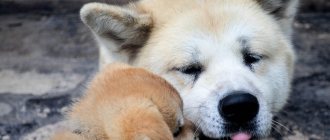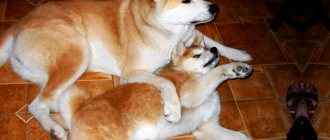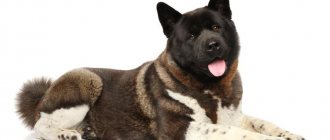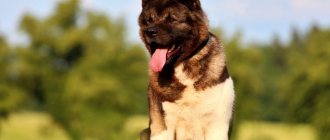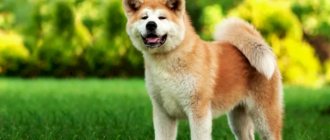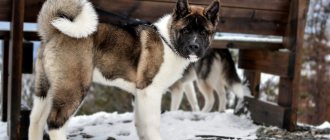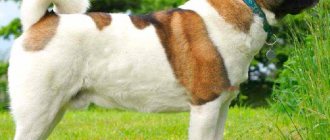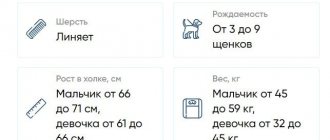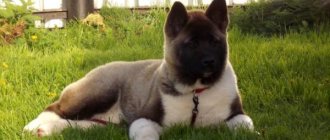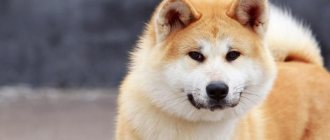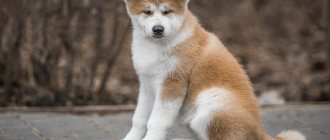Akita Inu (English Akita-inu, Japanese 秋田犬) is a breed of dog native to the northern regions of Japan. There are two different types of dogs: the Japanese line known as Akita Inu (inu is Japanese for dog), and the American Akita or large Japanese dog.
The difference between them is that the Japanese line accepts a small number of colors, while the American line accepts almost all, plus they differ in size and head shape.
In most countries, the American is considered a separate breed, however, in the USA and Canada they are considered one breed, differing only in type. These dogs are best known for the story of Hachiko, a faithful dog who lived in Japan before World War II.
The Akita is a powerful, independent and dominant breed, aggressive towards strangers and sweet with family members. They are fairly healthy, but may suffer from genetic diseases and are sensitive to certain medications. Dogs of this breed have short hair, but due to a recessive gene, dogs with long hair are found in many litters.
Theses
- They are aggressive towards other dogs, especially those of the same sex.
- These dogs are not for novice dog owners.
- Socialization and persistent, competent training are extremely important for these dogs. If they have not been treated or raised correctly, they often become aggressive.
- They shed a lot!
- They get along well in an apartment, but need walks and physical activity.
- They are excellent guards, attentive and reserved, but they need a firm hand.
Who is the dog suitable for?
The American Akita is a dog with a serious character, so it is not suitable for a beginner . Her upbringing requires constant monitoring until the desired behavior is fully consolidated. However, they remember commands easily, and Akitas quickly get used to life in society. They are popular among active people and avid hunters. They need to be taxed mentally and physically, making it difficult for older people to cope with the wayward nature of Akitas.
They behave decently in the family if they know their place in the so-called pack. They stand up to protect property. American Akitas are found in families with children, but due to their large size, it is better to limit their interaction with children for a while.
Hunting sense and working qualities are often the reasons for fights with other dogs , especially of the same sex. They can attack cats, birds, rabbits and domestic rats, thinking about prey. To go outside, prudent owners purchase a muzzle .
The best housing for an American Akita is a private house with a large yard and free range. They are also kept in enclosures, subject to regular exits outside the site.
Representatives of the breed often live in apartments, but for city walks you need to take the upbringing and socialization of your pet seriously.
Can become an excellent security guard . These dogs have a developed sense of smell and are wary of strangers. After guard training, the American Akita will be able to correctly detain or bark an intruder who has entered the owner’s territory.
History of the breed
Japanese sources, both written and oral, describe the ancestor of the breed, the Matagi Inu dog (Japanese: マタギ犬 - hunting dog), one of the oldest dogs on the planet. Matagi, an ethnosocial group of Japanese living on the islands of Hokkaido and Honshu, are born hunters.
And it is the island of Honshu (Akita Prefecture) that is considered the birthplace of the breed, the place that gave the name to the breed. The breed's ancestors, the Matagi Inu, were used exclusively as hunting dogs, helping to hunt bears, wild boars, serows and Japanese macaques.
This breed has been influenced by other breeds from Asia and Europe, including: English Mastiff, Great Dane, Tosa Inu. This happened at the beginning of the 20th century, due to the growing popularity of dog fighting in the city of Odate and the desire to get a more aggressive dog.
According to some sources, they were crossed with German Shepherds during World War II to avoid government regulations requiring that all dogs not suitable for war be destroyed.
To understand the history of the breed, you need to understand the history of the country. For hundreds of years it was an isolated country ruled by shoguns. A professional army made up of samurai helped maintain power in Japan.
These people were brought up with contempt for pain, both their own and that of others. It is not surprising that dog fights were very common, especially in the 12th and 13th centuries. This harsh selection has left very few dogs that are kept as pets and for entertainment.
But, in the 19th century, the industrial era begins. The country needs metals, gold and silver. A lot of city dwellers are moving to rural areas, which increases the number of thefts and crimes. The peasants are forced to retrain the Matagi Inu (purely a hunting dog) as a watchman and guard.
At the same time, new breeds of dogs are coming from Europe and Asia, and dog fighting is again gaining popularity in the country. Opponents include both Tosa Inu (another Japanese breed), and mastiffs, Great Danes, and Bullmastiffs. Owners cross them with indigenous breeds to create larger, meaner dogs. However, this worries many Japanese as the native dogs begin to dissolve and lose their features.
In 1931, the breed was officially declared a natural monument. The mayor of Odate City (Akita Prefecture) creates the Akita Inu Hozankai Club, the purpose of which is to preserve the originality of the breed through careful selection. Several breeders breed these dogs, avoiding those individuals whose features show hybridization.
The breed is called Odate, but later renamed Akita Inu. In 1934, the first breed standard appeared, which would later be amended. In 1967, the Akita Dog Preservation Society created a museum that stores documents and photos about the history of this breed.
The real blow for the breed was the Second World War, during which the dogs practically disappeared. At the beginning of the war, many of them suffered from malnutrition, then they themselves were eaten by the starving population, and their skins were used as clothing.
In the end, the government issued a decree according to which all dogs not participating in hostilities must be exterminated, as a rabies epidemic began in the country. The only way to save the dogs was either to shelter them in remote mountain villages (where they again crossed with the Matagi Inu) or cross them with German shepherds.
It is only thanks to Morie Sawataishi that we know this breed today, it was he who began to restore the breed after the occupation. Hobbyists restored the stock, looked for only purebred dogs and avoided crossbreeding with other breeds.
Gradually their number increased, and the American military and sailors brought these dogs home. By 1950, there were about 1,000 registered dogs, and by 1960 this number had doubled.
American Akita
The paths of the Akita Inu and the American Akita began to diverge after World War II. At this time, Japan, as a losing country in the war, was under US occupation, and there were many American military bases on its territory. The military were fascinated by the large Japanese dogs and tried to bring the puppies to America.
However, the Japanese did not feel any desire to share high-quality, purebred dogs, which they themselves collected bit by bit throughout the country. And the Americans themselves preferred large, bear-like dogs, mixed breeds with other breeds, small and graceful.
American fanciers of the breed bred a larger, heavier and more menacing dog, calling it the Great Japanese. Although both types come from the same ancestors, there are differences between American and Japanese dogs.
While any color is acceptable for American Akitas, Akita Inus can only be red, red-fawn, white, spotted. Also, American ones may have a black mask on their face, which for Japanese ones is a reason for disqualification. The American ones are heavier boned and large with a bear-like head, while the Japanese are smaller, lighter and have a fox-like head.
To gain recognition from the AKC, US breeders agreed to stop importing dogs from Japan. Only those that were in the USA could be used for breeding. This made the gene pool very limited and minimized the possibility of breed development.
The Japanese, on the other hand, were unlimited and could develop the breed as they saw fit. They focused on producing dogs of specific colors and sizes.
As a result, the American Akita and the Akita Inu, although they have common ancestors, differ from each other in many ways.
Origin history and interesting facts
The history of the American Akita breed begins with the history of the appearance of the Akita Inu. It is this that is considered the most important milestone that predetermined the emergence of the large Japanese dog. It all started when American soldiers who fought in Japan during World War II fell in love with fluffy Akita puppies and took several with them to their homeland after the end of their combat mission. Akita Inu puppies brought from the Land of the Rising Sun became a kind of springboard for breeding a similar, but fundamentally new breed. At the official level, the name American Akita was assigned to it.
- The oldest of the “Japanese”. Akita Inu is considered the oldest dog breed in the Land of the Rising Sun. Researchers have found animal figurines made of clay, visually reminiscent of an Akita, dating back to the second millennium BC.
- Universal breed. Japanese mountaineers used these dogs to hunt bears. In the world, Akitas regularly performed the functions of watchmen and security guards, brilliantly coping with any task assigned to them.
- Four years of success. In 1956, the first club of breeders of the breed under discussion was founded in the USA. While the Japanese after the war tried to “cleanse” their national treasure—dogs—of European impurities, the Americans, on the contrary, continued to mix things up. The large Japanese dog in its modern guise appeared to the world four years after the founding of the first “fan club” - in 1960.
Description
Like other Spitz breeds, it is adapted to life in cold climates. Characteristic features of the breed are: a large head, erect, triangular ears, a curled tail and a powerful build. Adult males reach 66-71 cm at the withers and weigh 45-59 kg, and females 61-66 cm and 32-45 kg. Dogs of Japanese origin are usually smaller and lighter.
The size and weight of puppies will vary depending on the individual, but in general you can expect:
- for American Akita puppies aged 8 weeks: from 8.16 to 9.97 kg
- for Akita Inu puppies aged 8 weeks: from 7.25 to 9.07
These dogs grow slowly and reach full development by the third year of life. The growth rate of puppies may vary, some gradually increase in size week after week, others grow quickly, then slow down.
In general, a gain of 5.5 to 7 kg each month can be considered normal until the dog gains 35-40 kg. From this point on, growth slows down, but does not stop until the dog reaches its full potential.
There are growth charts, but don't worry if your puppy doesn't meet them, they are very general.
- 6 weeks of age: At this age, puppies are already impressive in size, although they take 3 years to fully develop.
- Age 6 months: at this age it already resembles the dog it will be as an adult. The proportions of the body have become more pronounced, the roundness characteristic of puppies has disappeared.
- Age - 1 year: despite the fact that by this time the females have already begun to heat, they are not yet fully grown.
- Ages 1-2 years: Growth slows, but body shapes change, especially the head. This is a slow process, but over time you will clearly see changes.
- Age 2: Physical development slows down significantly at this time, although there will still be changes over the next 12 months. The dogs will stop growing in height, but will become noticeably wider, especially the chest.
Cost and where to buy
It is difficult to answer the question of how much an American Akita costs. It all depends on the class to which the purchased puppy belongs. There are three such classes in total (prices are indicated for January 2022).
- Pet class. This class includes pets without documents and pedigree. The cost of a large Japanese pet-class dog puppy varies from 10 to 12 thousand rubles.
- Breeding class. Puppies that are considered suitable for continued breeding will cost the dog breeder from 15 to 30 thousand rubles.
- Show class. Babies whose exhibition prospects are characterized as excellent cost from 50 thousand rubles. The parents of such a fluffy little beauty are often current champions.
The table will tell you the approximate cost of American Akita puppies in Moscow and St. Petersburg (data is current as of January 2018).
Table - Price of a large Japanese dog in Moscow and St. Petersburg
| Puppy class | Price in Moscow, rubles | Price in St. Petersburg, rubles |
| Pat | 20 000-40 000 | 20 000-35 000 |
| Breed | 40 000-80 000 | 40 000-60 000 |
| Show | 80 000-120 000 | 60 000-120 000 |
List of nurseries
Having decided to buy a dog, you need to visit one of the American Akita breed kennels. Ideally, this should be a breeder you know or have been recommended to you by trusted people. At a minimum, he must have been breeding for more than a year and be present on the domestic market for at least three to five years. Don’t be lazy, read reviews about a potential place to buy a puppy on the Internet. Below you will find a list of the largest Russian breed nurseries:
- “Japanese Garden” in Moscow - https://www.akita-usa.ru/;
- Luckiy Star Akitas in Moscow - https://www.americanakitaclub.ru/;
- “Lord of Muscovy” in the Moscow region - https://www.akita-usa-bullmastiff.com/;
- Rasstar in Moscow - https://www.americanakitaclub.ru/;
- "Akita American" in St. Petersburg - https://www.akita-american.ru/;
- Rikoran in St. Petersburg - https://www.rikoran.com/aa_shenki.html;
- Versato in Volgograd - https://akitas.narod.ru/kennel.html.
Having chosen a puppy, go meet his mother and father. If one of the parents shows excessive aggression or, conversely, cowardice, think about it. There is a risk that the baby has adopted this quality from mom and dad and may be the same. Ask the breeder about vaccinations. He should give you comprehensive recommendations about vaccination. At the time of purchase, the baby must have routine vaccinations in accordance with his age.
You should also know that small American Akitas are not assigned any class until they are nine months old. The most that a professional in this field can do is to examine the baby and assess its prospects. That is, to assume which class he will be assigned to after reaching maturity. The description of the American Akita breed will partly help you visually evaluate the baby. He should not have limbs turned outward or inward and red eyelids. The eyes should be dry and clean, and the fluffy puppy himself should be active. Lethargy and depression are an alarming signal indicating health problems.
Video on the topic: A story about the American Akita dog breed
Wool
According to the American Akita breed standard, all types of colors are acceptable, including white, as well as a black mask on the face. Japanese dogs can be red with white color on the inner surface of the paws, chest and muzzle mask (the so-called “urajiro”), brindle with white urajiro, white. A black mask on the face is not acceptable.
There are two types of coats: short-haired and long-haired. Longhairs are not allowed to participate in the show and are considered a cull, but in character they are no different from shorthairs.
Long hair, also known as Moku, is a consequence of an autosomal recessive gene that only manifests itself if the father and mother are carriers.
Advantages and disadvantages of the breed
There are both positive and negative reviews regarding the American Akita. The advantages include the following features:
- loyalty and devotion;
- strong psyche;
- hunting abilities;
- cleanliness;
- gets along well with the child;
- protects the territory and the owner.
Flaws:
- severe shedding;
- independence;
- cannot be kept in the same area as small pets;
- need for daily long walks.
Ears
One of the most common questions when an Akita's ears stand up? Adult dogs have erect ears, while puppies have downward ears.
Many owners worry about this, wondering at what age they will rise. Their excitement is understandable, since according to the breed standard, the ears should be small, erect and slightly tilted forward.
If you have a small puppy, then there is no need to worry. There are two points that are responsible for this process. The first is age. The ears will rise as the puppy gets older, as the muscles at the base of the ears need time to strengthen. Chewing speeds up this process as these muscles are connected to the jaw muscles. They become stronger during eating, and also when the puppy chews on toys or plays.
The second point is the loss of baby teeth. Don't expect your puppy to have erect ears until the teeth are completely replaced.
It often happens that they rise, fall, or one ear is erect and the other is not. There is no reason to worry, everything will even out over time. This process usually begins at 10-14 weeks of age and ends before six months of age.
What to feed a large Japanese dog
The diet of an Akita depends very much on how much time the owner can devote to the dog. If he prefers natural feeding, then you need to choose high-quality products. Half of the diet must be meat. While the puppy is small, you can give cottage cheese, kefir, eggs, boiled chicken, fish, fruits, if he likes them. If the owner chooses industrial feed, then he should give preference to super-premium and premium products.
You need to feed your dog on a schedule so that it gets used to discipline. Up to six months, give food three times a day, and by nine months, switch to two meals a day. Watch your portions. If your puppy is regularly undernourished or has swollen sides after meals, feed less food. Bones, cartilage, raw fish and baked goods are not suitable for dogs. Mixing natural food and feed is not recommended.
Eyes
Pedigree dogs have brown eyes, dark brown is preferable. They are small, dark, deep-set and have a characteristic triangular shape. This form is a physical difference and must be present from birth.
If your puppy has round eyes, this will not go away with time. Also, the color of the eyes does not darken over time, but, on the contrary, brightens. Some, with light fur, may have a black line around the eyes, eyeliner. If it is present, it only enhances the eastern shape of the eyes.
TOP nicknames
You can name your American Akita (“girl” or “boy”) any name you like. The main thing is to comply with two mandatory rules that breeders replicate.
- First letter of the name. Breeders request that breeding dogs be named after the first letter of the litter name.
- Factory attachment. If in the future you intend to give your dog documents, but today you take him from the kennel, when choosing, take into account the factory prefix, which is added to the main name of the dog. The factory prefix allows breeders to distinguish their dogs from the general mass of four-legged pets. And if your puppy has one, be guided by its sound when choosing the main nickname.
The table suggests ten nicknames for females and males of the large Japanese dog breed. Perhaps one of them will help you name your American Akita (“boy” or “girl”) not only in accordance with the rules, but also with your personal preferences.
Table - Nicknames for American Akitas
| "Boy" | "Girl" | ||
| Nickname | Translation | Nickname | Translation |
| - Aka; — Gin; — Yoshiko; - Kabuto; - Keith; — Kyoka; — Mori; - Fuku; — Torah; — Satu | - Red; - silver; - good child; - shield, armor; - north; - happy; - forest; - lucky; - tiger; - sugar | — Yume; - Choco; - Chico; - Hana; — Fuji; — Toshi; — Oji; — Miki; — Sakura; —Ichigo | - Dream; - chocolate; - arrow; - flower; - wisteria; — reflection; - tree; - flower stem; - cherry blossom; - strawberry |
Lifespan
The average life expectancy is 10-12 years, which is slightly less than that of other breeds of similar size. Females live slightly longer than males, but the difference is not very significant and amounts to a statistical 2 months. Moreover, it is typical for both Japanese and American Akitas, since they have the same roots.
Life expectancy was affected by the war, especially the bombing of Hiroshima and Nagasaki, since before it dogs lived 14-15 years. Don’t forget that large dogs usually live less than small ones, suffer from serious joint problems, and their hearts have to work harder.
Diseases and treatment
Representatives of the large Japanese dog breed are very hardy. But the list of diseases that develop in American Akitas more often than in others is still quite long.
- Volvulus. Predisposition to the disease is determined by the internal structure of the digestive system. With timely intervention from a veterinarian, the dog will not face any harm.
- Eye ailments. American Akitas often suffer from retinal atrophy and other diseases that affect the visual organs. The only, but quite effective, prevention is regular eye care.
- Cushing's syndrome. The disease is associated with disruption of the adrenal glands and entails a restructuring of the hormonal system. Requires mandatory drug treatment.
- Pemphigus foliaceus. This skin disease develops in older American Akitas. Dogs over eight years of age are more prone to the disease.
Paws
The description of the paws is the same in all standards, but differs in details.
Japanese Akita Club of America: Paws resemble those of a cat, thickly padded, arched, stable.
AKC: Cat-like, arched, straight.
Both types of Akita, Japanese and American, have paws with closed toes, which allows them to swim perfectly. They use both their front and hind legs when swimming, unlike other breeds that only use their front legs. At the same time, most of them do not like to swim and only enter the water if they are forced to do so.
Appearance of American Akita
Not a single element of the American Akita's body distracts from the overall appearance of the dog - everything is proportional and harmonious.
The American Akita is a large, powerful dog with strong, well-developed bones, harmoniously built with a square body. Her head is massive, wide with a flat skull, square and powerful jaws, and a voluminous muzzle. The transition from forehead to muzzle is well defined. The nose is large and black. The lips are thick, tightly fitting, black.
The eyes are deep-set, small in size, triangular in shape, dark brown in color. Unlike other dogs, the eyes of the American Akita are not only “loving”, but also cunning, aware of their purpose for the owner.
The ears are erect, thick, small in size, triangular in shape, with rounded ends, slightly tilted forward towards the eyes. The neck is quite short, powerful and strong. The back is straight and muscular. The chest is well developed, deep and wide. The limbs are straight, parallel to each other with powerful muscles. The tail is set high, thick, covered with hard and dense hair, held above the back by a ring or double ring.
The coat is straight, not lying flat, with a soft, thick and dense undercoat. At −30 C°, a dog will sleep carefree on the street.
The color is quite varied and can be anything: white, fawn, red, piebald, brindle. There may be a mask or a mark on the muzzle. In piebald dogs, large spots cover more than one third of the body.
Tail
The tail is the same feature of the breed as the shape of the eyes. It should be thick, rolled into a tight ring.
Newborn puppies have a straight tail, which changes its shape quickly, within two months. By this age, owners will notice the tail curling into a ring. If a breeder sells a puppy over 8 months old and its tail is straight, then this is a bad sign. It may curl up after this age, but there is a chance that it will remain straight.
As the puppies grow, the ring becomes tighter and the tail becomes thicker. It may be slightly straightened when the dog is relaxed or sleeping, but by this breed's strict standards it should never be straight.
The length of the coat on the body of the Akita Inu is about 5 cm, including on the withers and croup. But on the tail it is a little longer; in fact, it is on the tail that the dog has the longest and fluffiest hair. The tail, as it were, balances the dog’s powerful head; it should be thick, fluffy, and does not depend on whether the dog sheds or not.
Training issues
Training an American Akita is not as difficult as novice dog breeders write on forums. The main thing in education is to take into account the characteristics of this breed.
- Pride. It may seem to you that your pet is not listening to you at all. This is a manifestation of his pride and love of freedom. Such a dog has its own point of view and can insist on its own position. But as soon as she is convinced that the owner is a greater leader than herself, all questions will immediately be removed: the four-legged friend will begin to give a paw and bring a stick on the owner’s orders.
- Denial of violence. Applying physical force to an animal entails a loss of trust. Do not try to force anything from your American Akita. The dog will stop trusting you, and regaining trust will be extremely difficult.
- One dog, one owner. The dog must be trained by someone alone. The American Akita treats the human family with tenderness and love, but will unquestioningly obey only a specific person.
Advantages and disadvantages
Owner reviews of the American Akita are sometimes very different from each other. Some say that the dog is difficult to train. Others claim that raising a dog is easier than a steamed turnip. The large Japanese dog has its pros and cons, just like any other pet. The table will briefly and succinctly tell you about them.
Table - Advantages and disadvantages of the large Japanese dog
| pros | Minuses |
| - Loyalty; - devotion; — excellent hunting qualities; — cleanliness; – high security potential | — High level of animal independence; - excessive hair loss during molting |
American Akitas are born with floppy ears. According to the breed standard, the ears should stand up when the dog reaches four months of age.
Character
The question about character cannot be given a short, simple answer. These incredible dogs cannot be described in a few short, simple phrases. The character of the American Akita is slightly different from that of the Japanese Akita Inu.
Americans are more serious, Japanese are a little more frivolous. But, most of them are neither a stupid couch dog nor a serious, gloomy dog. Akita is the golden mean.
Here's what you can expect from these dogs:
Independent thinking - sometimes mistaken for stubbornness.
Sense of rank - If the owner has a couple of dogs or more, each will have its own rank. Everyone will want to be the first to eat, the first to enter the house, the first to leave, etc. That is why it is extremely important that from the first day they learn that a person is on top and do not try to dominate.
Tendency to learn quickly - they pick up everything on the fly and begin to get bored if the same thing is repeated to them. They quickly understand what they want from them, but their character requires that they understand why they need it. Therefore, it is very important to find the right motivation for your Akita Inu.
Well suited for an apartment - despite their size and thick coat (sometimes shedding), they are excellent for living in an apartment. They often live successfully even in cramped, one-room apartments.
They are not afraid of heights - that is why balconies must have a fence. Puppies have more courage than intelligence, plus adult dogs jump high, and they don’t care where they land.
They love space - most will be happy walking with you on the beach or field. Their character has a sense of freedom and space, plus they love physical activity, new places and smells.
Sensitive - Although they can handle physical pain well, their feelings are easily hurt. Don't let the size fool you.
Loyalty - they will not pester you or poke their nose at you, inviting you to play. Their loyalty is calm and quiet, but very strong. Adult dogs love to lie quietly next to their owner while he watches TV. You may think that she is sleeping, but they are aware of the owner's every move. And if you go to another room, what will happen? Akita is already here, like your shadow.
Patience is incredible, but these dogs, being dominant, are unobtrusive and very patient. They will be bored and lonely without you, but they will patiently wait for your return. They can, without making a sound, stand by your bed and look at you for hours, waiting for you to wake up.
Respect for elders - some are concerned about how they treat the elderly. Great! In the USA, they are even used in hospices for the support and psychological rehabilitation of the elderly. But with children it’s a different story; a lot depends on whether they are part of the family and how they behave.
Other dogs - many are great friends with other dogs, provided that they are smaller than them and live in the same family. But their friendship with strangers does not go well. In most cases, dogs of the same sex will not get along with other dogs of the same sex. Owners need to understand that instincts are strong and despite training, aggression will manifest itself in the form of growling. Aggression may be less if the dog is neutered and more if the opponent is of a similar size.
The bite dog is a guard dog and will keep an eye on strangers until it realizes that they are welcome guests. She may bite, but not indiscriminately. This is part of instinct, but it can be controlled with good training.
Claustrophobia - they are a little afraid of confined spaces and do not like enclosed spaces. Males love a good view and the feeling that they are in control of the space.
All dogs are pack animals, which means that they follow the hierarchy accepted in the pack, coming from the leader. All others are distinguished by a higher or lower rank.
The nature of the Akita forces it to be either dominant or to take the place indicated by the owner and then behave well towards him and his family members. But, they can be aggressive towards strangers and other dogs.
These dogs have a good and obedient character, but only if the dog has been well trained and if the owner understands what it can and cannot tolerate (according to its rank).
These are dominant dogs, they will follow a person as a leader, but will dominate other animals. This doesn't mean they don't get along with other dogs, it's a game that goes on in the background. An Akita Inu and a tiny dog can be best friends.
Aggressive temperament (in fact, an attempt to find out one’s rank in the outside world) begins to appear between the ages of 9 months and 2 years. Akita begins to ignore someone or something that he should do, he can growl, and if he is left with no choice, he can bite. And it is the owner’s responsibility to be prepared for this situation and react correctly to it.
Mating
Before breeding an American Akita, the female must be prepared. First of all, get vaccinated. Manipulations are carried out 1 month before the planned estrus. Vaccination will strengthen the dog’s immunity and eliminate the risk of complications.
If vaccinations are not necessary, then be sure to give an anthelmintic to prevent parasites. Anti-tick and flea medications are allowed to be used no later than 2 weeks before mating.
Mating is carried out 2 times to ensure fertilization.
Ideally, 2-3 weeks before the heat, the dogs should be introduced and walked together. When the time comes for mating, the female will behave more favorably towards her partner.
Note! It is important to choose a secluded place, without other animals or people who might disturb your pets.
Attitude towards children
It largely depends on the character, behavior of the children and the age at which the Akita first encountered them. Puppies that grow up with children usually get along great with them.
Problems may arise if the dog is an adult and protects “its children.” They may interpret loud screams, running, fighting, and active games as an attack and will rush to defense. It is important not to leave such a dog unattended and to actively engage in socialization in order to accustom it to the activity and noise of children.
Key points in training
When training, it is worth remembering that the dog has a strong and independent character, so training should begin as early as possible, while showing calm and perseverance.
- The dog responds to aggression with aggression, so under no circumstances should you raise your voice, hit the Akita, or look directly into the eyes. You need to talk to your pet in a calm tone.
- Food rewards do not work on representatives of this breed; you need to look for an individual approach to your pet.
- Akita will not tolerate monotonous and boring training - it is better to present training in the form of a game.
- You should not force your dog to engage in physical activity if it is tired or uninterested.
- You should not allow the dog to jump on a person, butt heads or demand attention - otherwise the Akita will stop obeying.
If you do not have confidence in your own abilities, it is better to entrust the dog to a professional trainer.
Read about how to properly train a dog in the article: “Training a puppy: effective methods from dog handlers, learning commands at home.”
Socialization
Socialization should be done as early as possible, the most important time being from 3 weeks to 4 months. What is instilled in the puppy at this time will manifest itself as it grows. It is at this time that the Akita will find mutual understanding with the person or not. In addition, at this age the puppy learns about the world and must understand that this world is as big as its owner allows it to be.
It is important to introduce your puppy to as many places, people and events as possible. Everything that is laid down at this age will have a great impact on his entire life. He will absorb all impressions and draw conclusions from them. And when the Akita reaches 1 year, these ideas take root and can no longer be corrected.
This age is the foundation on which all further behavior of the dog is built. Although adult dogs can be retrained, changing attitudes is much more difficult than shaping them.
Don’t forget that before introducing your puppy to the world, you need to get all the necessary vaccinations and wait a while.
Table of weight and height by month
| Age | Height at withers, cm | Weight, kg | ||
| Male | Bitch | Male | Bitch | |
| 2 months | 35-38 | 31-35 | 8-9 | 7-8 |
| 3 months | 38-43 | 35-41 | 13-15 | 11-14 |
| 4 months | 43-51 | 41-48 | 18-21 | 15-18 |
| 5 months | 51-56 | 48-54 | 22-25 | 20-22 |
| 6 months | 56-61 | 54-58 | 27-30 | 24-26 |
| 9 months | 61-63 | 58-61 | 32-36 | 28-32 |
| 1 year | 63-67 | 61-64 | 36-39 | 34-38 |
| 18 months | 67-71 | 64-66 | 40-44 | 38-42 |
The data given in the table is averaged. Minor deviations are not a cause for concern.
Socialization of puppies
From the moment it enters your home, your attitude is very important. Establish yourself as a leader from day one. Often, owners are touched and allow the puppy to behave inappropriately, because he is still so small.
However, he already understands and makes his place in the family. Of course, owners must be loving and caring and create a safe and calm environment. But, as already mentioned, socialization means that the dog must understand the leading position of the owner. If she doesn't consider him dominant, trouble will follow.
This breed will definitely dominate its owner if the owner does not take steps to prevent this situation. Look at the ads, read the forums. It's a shame how often owners get rid of Akitas, or even euthanize them, unable to cope with their pet.
- Introduce your puppy to the house and property, but do not leave him alone at home. If he stays on his own, then only indoors (but do not forget about the claustrophobia of this breed).
- Immediately begin training and mastering commands. Akitas understand basic commands (sit, down and come) as early as 8 weeks of age. Daily training and in a couple of months they will learn everything.
- Handling puppies is an essential part of socialization. All family members should hold him in their arms, stroke him and play with him. In the future, this will help your dog cope more easily with things like bathing, brushing, and going to the vet.
- Teach your puppy that you can take away his favorite toys and even food. Adult dogs can be unexpectedly aggressive if their toy or food is taken away from them and this can lead to problems. Continue doing this at 2, 3, 4, 5 months. You take the toy (not as a tease, but as a fact), pause, and then return it. When this is done constantly, the puppy gets used to the fact that the owner can be trusted, and he will always return the well-deserved item.
- There is a great temptation, but you should not allow the puppy to sleep in the owner's bed. This in itself will not lead to any problems, but you need to teach the dog that the leader sleeps in the bed, and she sleeps on the floor.
- The command “sit” should be given before the puppy is given anything to treat.
- The owner needs to be firm, not scary. You want your dog to respect you, not fear you.
Nutrition
The diet of the American Akita should be complete and balanced. Dogs of this breed are not at all picky about food, however, you need to take the choice of food for your pet quite seriously.
First, decide which type of food is more convenient for you: the dog can be fed with special ready-made food, or with natural food.
Many dog breeders choose dry food due to its balanced composition. In addition, such nutrition takes a minimum of time from the owner. The main thing is that the food is of high quality, without dyes and preservatives, the food should contain meat, not soy and by-products.
Others prefer to feed their pet natural products, which must be fresh and of high quality.
If you are in doubt about what exactly to feed your dog, you can ask her. It happens that an Akita refuses dry food, but happily eats a fresh piece of meat.
If you decide to feed your dog natural food, do not forget about mineral and vitamin supplements. It is better to consult a veterinarian or a breeder who is much more familiar with this breed of dog.
Remember that representatives of this breed often have digestive problems. Therefore, carefully monitor the number of servings your dog receives and do not overfeed him.
Feed your dog after a walk. After eating, the Akita must rest.
Do not give your dog fermentable foods, sweets, yeast baked goods, potatoes, sausages, long bones, fatty foods, or foods seasoned with spices. Food must be at room temperature.
Remember that the basis of the diet is protein foods of animal origin (lean meat, offal, sea fish, dairy products, eggs).
During the cold season, when the dog spends much more energy, fats are required. For example, vegetable oil and fish oil can be added to cereals (rice, buckwheat, oatmeal). Don't forget about fruits and vegetables, which are rich in fiber and vitamins.
Getting to know the outside world
You, as the owner, decide how big the world around her will be. An adult Akita cannot be expected to behave sedately if the environment is new to him. She will be on her guard and will not be able to focus on what you order her. This type of socialization should begin as early as possible. Once all vaccinations have been completed, introduce the puppy to as many places and environments as possible.
- Always keep your Akita Inu on a leash, this will give you much more control.
- While walking around the area is important, don't limit it to just that. Change routes, choose different roads every day. Take your puppy to parks, markets, stores, lakes, beaches, pet stores and plantings.
- You already know that Akitas do not tolerate other dogs well. However, they can be trained to cope without incident. When walking, don't avoid other dogs. If both are on a leash, allow mutual sniffing. If there are signs of aggression, such as growling, separate them. But, if the acquaintance is calm, do not interrupt it.
- Teach you how to calmly travel in a car. Start with short trips of 5-10 minutes a day, working up to 30-45 minutes.
Features of puppies and how to make the right choice
Mother and baby
Babies only from three weeks of age begin to move independently, go to the toilet and become interested in the world around them. To reduce the risk of acquiring a sick or non-standard baby who will subsequently not be able to participate in exhibitions, you need to buy it from a special nursery. Good breeders value their reputation and will not introduce deliberate defects or sickly babies.
On your first visit to the nursery, you need to pay attention to the condition of the female and the living conditions of the babies. If there is dirt, unpleasant odors and exhausted dogs, it is better to look for another seller. When purchasing, you need to discard young animals if they have the following deviations:
- constant lacrimation;
- bloated stomach;
- excessive, unnatural thinness;
- dull and sparse coat;
- rashes are visible on the skin, there is dandruff;
- the puppy is constantly itching, coughing or suffering from diarrhea;
- for problems with standard coordination of movements;
- in case of pronounced malocclusion, the standards allow only a scissor or straight variant.
You should ask the breeder about the health of the parents and the presence of chronic diseases. Some diseases can be inherited and it is important to know about them. At the same time, the buyer should take a closer look at the behavior of the young animal’s mother - if the animal is completely uncontrollable, then such a negative aspect may appear in the offspring.
The seller must provide a pedigree and a veterinary passport of the baby, which must record the first vaccinations and deworming procedures performed. If a purebred exhibition animal is purchased, its pedigree must be issued by the RKF.
Important! When choosing by gender, you need to take into account that girls have a calm and flexible character. Boys are the most stubborn and temperamental.
Care
There is nothing difficult about grooming, but there are a few things that need to be done regularly to keep your dog healthy and beautiful. They say that they are very clean and their owners do not need to take care of them. But that's not true.
Yes, they lick themselves, but this is not enough to get rid of all the hair that falls out. Moreover, they shed heavily twice a year. The coat does not require special care - just brushing it once a week is enough. During seasonal molting, you need to comb it more often, 3-4 times a week.
In addition, you need to regularly examine the ears, trim the nails, bathe, comb and sometimes brush the teeth. In general, caring for them is no different from caring for other large breeds of dogs.
Requirements for maintenance and nutrition
The luxurious coat is one of the advantages of the American Akita, which distinguishes it favorably from the Japanese classic Akita Inu. However, those who like to stroke their dog’s plush skin will have to arm themselves with special brushes and combs in order to carry out regular grooming during the molting period.
- Daily walk. The American Akita dog needs long walks every day. These dogs are quite active, they have a lot of energy that needs to be released.
- Claw care. Practically not required if you walk your dog regularly. As a rule, the claws wear down on the road surface on their own, so they do not require additional trimming.
- Bath procedures. The large Japanese dog needs to be washed about a couple of times a year. These animals are distinguished by cleanliness, so the owner does not have to make any special efforts to clean the pet.
- Molting period. The longhaired American Akita sheds twice a year. As a rule, in the off-season. At this time, it needs to be combed twice a day. Otherwise, the house will drown in thick hair that the dog sheds directly onto the laminate.
- Teeth and ears. These parts of the animal’s body do not require any specific care. It is enough to brush your teeth once a week with a special brush and apply dog toothpaste, wipe your ears with cotton pads or special swabs dipped in liquid from a veterinary first aid kit or in ordinary hydrogen peroxide.
What to feed
Some say that it is better to feed the American Akita with ready-made food. Others claim that only natural food. The truth lies somewhere in the middle. When buying a puppy, listen to what the breeder says about this, listen to his recommendations. The main obstacle in the case of food is the price. Premium and super-premium food is not a cheap pleasure. Therefore, with the right approach, you can alternate ready-made meals with natural food. At the same time, you will remain 100% sure that your dog receives all the vitamins, minerals, micro- and macroelements necessary for development, growth and health.
- Fish lovers. American Akitas love fish and seafood. This is due to their island origin. Therefore, when choosing food, prefer these components to meat ingredients.
- Rice as a base. The basis of feed or natural food should be rice. The risk of allergic reactions when eating rice is minimal. While when eating chicken and wheat-based cereals, this risk increases significantly.
- Potatoes and barley. If your dog is a serious allergy sufferer, for a change, alternate rice food with food based on barley or potatoes.
- Vitamin supplements. The Great Japanese Dog is a large breed, which means its representatives need appropriate vitamin supplements. When purchasing products in this category, carefully study the label. It is better to avoid glucosamine-based vitamins, since such drugs should be prescribed exclusively by a medical specialist and cannot be used uncontrolled.
- Puppies nutrition. The diet of a puppy who has moved to a new home should not change too dramatically. Feed the baby what he is used to. For example, ready-made food soaked in yogurt or boiled fish and rice. After a month, you can begin to supplement your diet with vegetables, fruits and offal. During the period of active tooth growth (from four to nine months), the baby should be given vitamin D and calcium-containing vitamin supplements as a supplement.
- About taboos. The size of an adult American Akita reaches a maximum of one and a half to two years (females grow up somewhat earlier than males). Around this period, you will need to review and optimize your pet's diet, but the taboos are the same at any age: sweet, smoked, hot, salty and spicy. Dogs should not be fed fruits high in sugar. For example, grapes. Fried food is an absolute taboo.
While the dog is growing, you need to closely monitor how it eats. If there is something left in the bowl after eating, throw the leftovers in the trash, and next time reduce the serving size. If the dog, on the contrary, licks the empty bowl, increase the portion.
Diseases characteristic of Akita Inu
Based on reviews from Akita owners and the characteristics of the breed, it should be noted that the dog is in good health, but only if it does not have congenital malformations. Akitas have a predisposition to genetic diseases and sensitivity to certain types of medications.
Congenital or age-related ailments are represented by:
- retinal atrophy;
- entropy;
- von Willebrand disease;
- hip dysplasia;
- pseudoparalytic myasthenia;
- bloating;
- cataracts;
- glaucoma.
A timely visit to a veterinarian and proper care of your pet will help prevent the development of all these ailments.
Feeding
Akitas are indiscriminate eaters. The type of food must be adapted to their lifestyle. Dogs that don't exercise much should not be given too nutritious food because they will gain weight quickly. In turn, the menu of animals that live outside in winter should be rich in calories.
During shedding, you can introduce products that support hair regeneration and improve the condition of the animal's skin.
Feeding only dry food
Undoubtedly, this is a very convenient method that does not pose serious problems for a properly balanced diet. It is worth remembering that the feed doses recommended by the manufacturer are often too high. Therefore, it is better to give a little less so that the dog eats everything without leaving any leftovers in the bowl.
It is most convenient to give high-quality dry food with the addition of glucosamine and chondroitin for large breeds. However, food should not contain too much protein, because Akitas can have food allergies. Products with lamb or fish are excellent for feeding.
It is best if the food is pre-soaked in warm water. This way you can avoid unwanted gastrointestinal complications. If we pour dry food, it is necessary to ensure constant access to fresh water.
For those who choose this method of eating, one important piece of advice can be given - there is no such thing as good food and cheap food at the same time. It is better to buy food that is more expensive or at least in the average price range.
Feeding only natural products
A well-balanced meal should include foods that provide the dog with proteins - meat, fish, dairy products.
Beef (including offal), lamb, and poultry are best for dogs. The latter is never served raw due to the risk of salmonellosis. Fish – only sea fish, cooked with large bones removed.
White cheese is especially recommended for puppies and growing dogs. Lenten cheese is more desirable.
As for milk, it is recommended to give goat's or cow's milk. Both puppies and adult dogs are quite happy with natural yogurt, which can be added to their food. With the natural feeding method, eggs are also served: a yolk or a whole egg, well boiled.
Dogs are also given fats necessary to maintain proper skin and coat condition. Usually one tablespoon of vegetable oil is enough (usually in winter or during shedding). The best oils are corn and linseed.
Mixed feeding
This is a method that feed manufacturers don't really recommend. But many owners use this type of food without seeing any signs of harm to their dogs. They use dry food in combination with liver or fish, and also with the addition of a small amount of rice. Puppies alternately receive food and natural food.
Regardless of the feeding method, it is necessary to correctly divide the daily amount of food into smaller portions. Puppies up to 7 months are fed four times a day. Then, three times a day until 1 year. Further and throughout the life of the dog, the dog can have either twice or once feeding per day.
After eating, it is advisable to give your pet an hour of rest for better absorption of nutrients.
Interesting facts about Akita Inu
The Akita Inu dog breed has ancient roots. It appeared in the second millennium AD. Akitas were originally bred for hunting. But several centuries later, its qualities and external data were appreciated by aristocrats. At that time, the ruling elite of Japan issued a decree that people who harmed dogs of this breed would be sentenced to death. The nobles believed that having such a pet in their home attracted good luck, so they took care of them at the highest level.
The most famous of the Akitas was Hachiko. His sad story and devotion are known to the whole world and can touch the soul of the most callous person. It was after the release of the film about this devoted dog that the popularity of the breed skyrocketed.
The owners of these extraordinary dogs are Russian pop singer Glucose and Russian President Vladimir Putin.
Akita pets are called smiling dogs. This feature is due to the structure of their mouth, which creates the impression of a wide and good-natured smile on their face.
